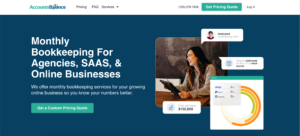
Looking to learn about Customer Acquisition Cost (CAC)?
You’ve come to the right place.
We’re going to break down everything you need to know in this article and offer some examples so you can see it in action.
My name is Connor Gillivan. I’m an Entrepreneur and I’ve scaled multiple companies to 6, 7, and 8 figures with monthly recurring revenue.
Right now, I run 3 companies where CAC is an important aspect of our growth.
Here’s what we’ll cover:
- What Is Customer Acquisition Cost (CAC)?
- Why Is Customer Acquisition Cost (CAC) Important to Your Business?
- How Do You Calculate Customer Acquisition Cost (CAC)?
- Customer Acquisition Cost Example #1: Marketing Agency
- Customer Acquisition Cost Example #2: SAAS Company
- Customer Acquisition Cost Example #3: Bookkeeping Service
- 5 Tips to Manage Your CAC
What Is Customer Acquisition Cost (CAC)?
CAC refers to the total cost a business incurs to acquire one customer.
This includes all the marketing and sales expenses involved in attracting and converting a prospect into a paying customer.
CAC is an essential metric to track as it determines the profitability of your marketing campaigns and customer acquisition strategies.
Knowing your CAC helps you understand the economics of your business, determine your return on investment (ROI), and set prices that ensure profitability.
If your CAC is too high, you may struggle to generate revenue or even make a profit.
Conversely, if your CAC is too low, you may be leaving money on the table.
As an agency or SAAS owner, it’s important that you start tracking CAC from Day 1.
The more data you have, the better.
Why Is Customer Acquisition Cost (CAC) Important to Your Business?
Knowing your CAC is crucial in managing your business’s profitability.
By calculating your CAC, you can determine whether your marketing and sales efforts are efficient or not.
This information can help you adjust your marketing strategies, target better customers, and ultimately increase your revenue.
By understanding your CAC, you can also calculate your customer lifetime value (CLV).
This will enable you to make more informed decisions about your marketing and sales efforts.
A lower CAC will increase your profit margins and allow you to invest more in your business’s growth.
In addition, a high CAC could indicate that you’re not targeting the right audience or using the right marketing channels.
By analyzing your CAC, you can make data-driven decisions about how to improve your customer acquisition strategies, resulting in a more efficient use of your resources.
CAC gives you a ton of data that helps across multiple areas of running and growing your business.
Without it, you’ll struggle to have a true financial picture of your company.
How Do You Calculate Customer Acquisition Cost (CAC)?

To calculate your CAC, you’ll need to determine your sales and marketing expenses and the number of new customers you’ve acquired within a specific period.
You’ll then divide the total sales and marketing expenses by the number of new customers to get your CAC.
It’s important to track your CAC over time to see how it changes as you adjust your marketing strategies.
This will enable you to optimize your customer acquisition process and improve your profitability.
In addition to your overall CAC, you can also calculate your CAC for specific marketing channels or campaigns.
This will allow you to identify which channels or campaigns are most effective, enabling you to allocate your marketing resources more efficiently.
We suggest having someone on your team (a virtual assistant or marketing assistant) that is responsible for calculating CAC for you each week or month.
Taking it off your plate and delegating it to someone on your team will make sure that you always have it handy.
If you try to keep it on your own plate, you may do it for a couple of months then forget and it will hurt your growth.
Customer Acquisition Cost Example #1: Marketing Agency
Let’s say you’re a marketing agency that spent $50,000 on advertising and sales in a month and signed up 10 new clients.
Your CAC would be $5,000 ($50,000 / 10).
If your average client lifetime value (CLV) is $10,000, your CAC is reasonable.
However, if your CLV is only $5,000, your CAC may be too high, making it difficult to turn a profit.
If your CAC is too high, you may need to re-evaluate your marketing strategy.
For example, you could try targeting a different audience with your advertising and marketing efforts.
Or you could lower your CAC budget and focus more on organic, more affordable strategies.
Customer Acquisition Cost Example #2: SAAS Company

Suppose you’re a SAAS company that spent $100,000 on advertising and sales in a month and acquired 1,000 new customers.
Your CAC would be $100 ($100,000 / 1,000).
If your monthly subscription fee is $50, your CAC is too high, and you’ll need to reduce it to turn a profit.
One way to reduce your CAC is to improve your conversion rate by optimizing your website or sales funnel.
Another option is to increase your customer lifetime value by offering additional products or services to your existing customers. By doing this, you’ll be able to increase your revenue while keeping your CAC low.
If your monthly subscription fee is $150, your CAC is at a great place and you still have room for margins.
Customer Acquisition Cost Example #3: Bookkeeping Service
Suppose you’re a bookkeeping service that spent $2,000 on advertising and sales in a month and acquired 20 new clients.
Your CAC would be $100 ($2,000 / 20).
If your average client lifetime value (CLV) is $500, your CAC is reasonable.
However, if your CLV is only $200, your CAC may be too high, and you’ll need to reduce it.
5 Tips to Manage Your CAC

From our experience managing and tracking customer acquisition costs, here’s 5 tips to keep in mind:
- Know your target audience: Understanding your ideal customer and where to find them can help you reduce your CAC by focusing on the most effective marketing channels and campaigns.
- Optimize your conversion rate: By improving your website or sales funnel, you can increase the number of visitors who convert into paying customers, reducing your CAC.
- Increase your customer lifetime value (CLV): By offering additional products or services to your existing customers, you can increase their CLV, making it easier to maintain a reasonable CAC.
- Focus on customer retention: By keeping your existing customers happy, you can reduce your CAC by encouraging them to refer you to their friends and family.
- Continuously track and analyze your CAC: By monitoring your CAC over time, you can identify trends and make data-driven decisions about your marketing and sales strategies. This will help you optimize your CAC and improve your business’s profitability.
You do these 5 things and you’ll set yourself and your business up for success.
There’s a lot more to CAC than just tracking and seeing what happens.
The smartest marketers and entrepreneurs use the data to make smart changes and decisions for their company.
What Customer Acquisition Cost (CAC) Should You Aim For?
When it comes to the ideal CAC for your business, there’s no one-size-fits-all answer.
The optimal CAC varies based on your industry, niche, business model, and goals.
As a general rule of thumb, your CAC should be less than the customer lifetime value (CLV) of your average customer.
In other words, the revenue you generate from a customer should be higher than the cost to acquire them.
For example, if your CLV is $500, you should aim for a CAC of less than $500 to maintain profitability.
However, keep in mind that a lower CAC isn’t always better, as it may result in lower quality leads or customers who aren’t a good fit for your business.
It’s crucial to balance your CAC with other metrics like conversion rates, customer retention, and overall profitability to ensure that you’re making smart business decisions.
Ultimately, the goal is to find the sweet spot where your CAC is reasonable while still allowing you to scale your business and achieve your goals.
What Is AccountsBalance?

AccountsBalance is a monthly bookkeeping service specialized for agencies & SAAS companies.
We take monthly bookkeeping off your plate and deliver you your financial statements by the 15th or 20th of each month.
You’ll have your Profit and Loss Statement, Balance Sheet, and Cash Flow Statement ready for analysis each month so you and your business partners can make better business decisions.
Interested in learning more? Schedule a call with our CEO, Nathan Hirsch.
And here’s some free resources:
In Summary
Customer acquisition cost (CAC) is a vital metric to track for any business that you’re running.
Whether it be an agency, a SAAS company, an eCommerce business, or a coaching business, you need to know your CAC to create profits.
If you still have questions about CAC, reach out to us at [email protected].
Thanks for reading!









